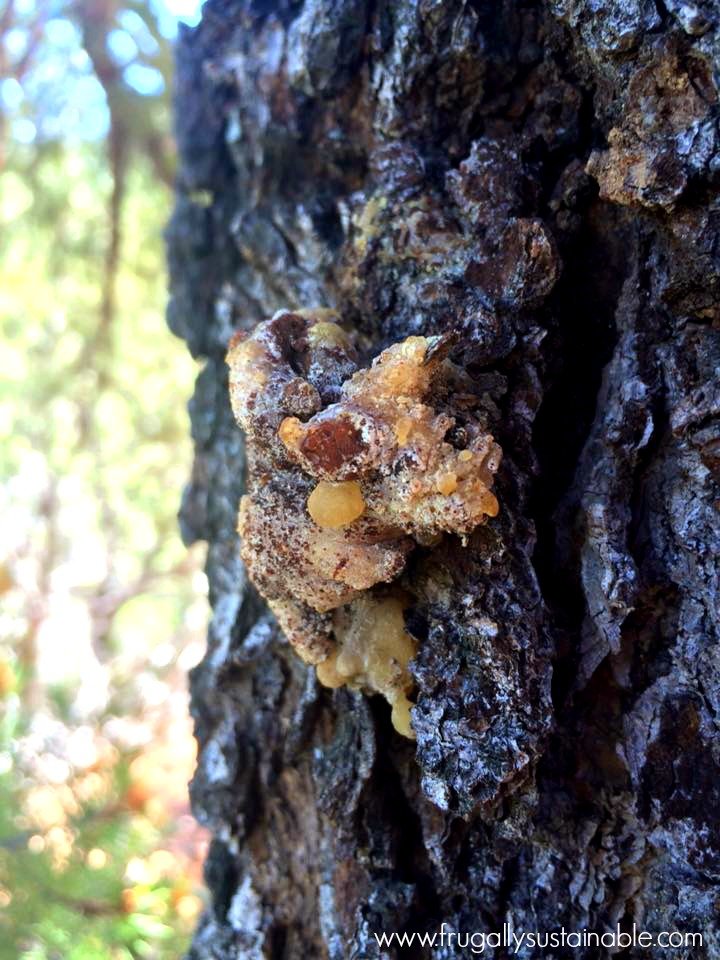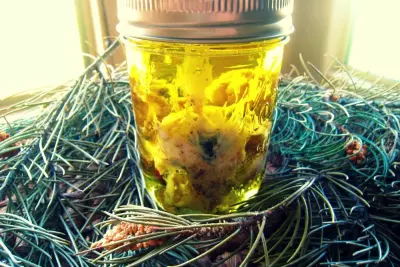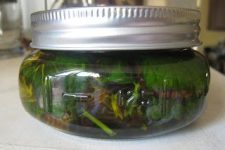I just returned from a backpacking trip to one of the most magical places I’ve EVER been…Fossil Spring, AZ.
In the plant world, this area of Arizona is known as the Juniper-Pinon belt. It contains such a unique collection of flora…in fact, most plants living here are known only to this region! And what an honor it was to share space among them.
In just a few short days, I was able to harvest numerous plants (under the energy of the full moon as a magical bonus).
One of the most notable, was the Pinon.
What is Pinon?
Pinon trees were everywhere along the trail! They provided the respite we so desperately needed to shade ourselves from the intensity of the sun. They also provided a bountiful harvest of healing plant material!
The inner bark, needles, nuts, and pitch from the Pinon have been used by inhabitants of the Southwest for centuries in medicinal preparations.
Here’s what Michael Moore, in his book Medicinal Plants of the Desert and Canyon West, has to say about Pinon ::
The needles make a very pleasant tea simply for the taste and have a mild diuretic and expectorant function as well. The inner bark boiled slowly for tea and sweetened with honey is still stronger as an expectorant, useful after the feverish, infectious stage of a chest cold has passed. The pitch is the most specific of all; a piece the size of a currant is chewed and swallowed. The is followed shortly afterward by strong, fruitful expectoration and a general softening of the bronchial mucus…[it is also] warmed slightly over a stove or campfire and applied to splinters, glass, and other skin invaders allowed to set, and peeled off, carrying the problem with it.
I am so thankful that I was able to gather a good amount of Pinon pitch (along with some needles)…
…I find it amazing that during the entirety of our hike, the pitch of the Pinon was drawing me it! I spotted it early on the start of our journey, and it was primarily what my eyes would focus on. My children even started pointing it out on every tree! I was unsure of what I would do with it…
…but it knew I needed to bring some back with me.

Harvesting Pinon Pitch
As with all acts of wild-harvesting, ethics is of utmost importance.
I always think it important to spend time with the plant, to ask permission to harvest, and to thank it for its gift…to consider the life + vitality of the plant and to not harvest more than I can reasonably use.
Pinon trees actually produce copious amounts of pitch as a means of healing for their own wounds. And by copious, I mean on some trees the pitch was literally dripping off the bark + branches and on some, I found pitch the size of a small apple!
Sincere and careful caution was taken in removing the pitch, so as to leave enough for the tree for continued protection and healing.
Methods for harvesting pitch are as varied as there are people harvesting. All I had were my hands and a small container. I simply used my fingers to easily collect the soft, pliable pitch from the bark of the Pinon and placed it in my container. Note :: Removing the sticky pitch from my fingers was as easy as rubbing some oil on my hands and it slid right off.
Benefits of Pinon Salve
It was on the drive home, I determined I would use the pitch to make a salve.
The benefits of Pinon Pitch Salve are pure magic! Due to its ability to draw blood and energy to the site of application, a salve made of Pinon has the power to heal ::
- psoriasis
- eczema
- bug bites
- boils/skin eruptions
- splinters
- severely dry skin
- sore + overworked muscles
- irritated/infected skin aliments
Not to mention, the smell of the salve alone possesses a level of healing all its’ own!

The Making of Pinon Salve
Through my research, I read of many different methods for making a salve with the pitch of Pinon. I settled on using traditional methods, allow me share my experience!
Ingredients
- 1 part wild-harvested Pinon pitch
- 2 parts organic plant-based oil (I used jojoba…mostly because at the time I harvested the pitch, jojoba bushes were growing EVERYwhere and all around the Pinon trees!! If we are mindful and take notice, Mother Nature gives us all the answers we need. So, jojoba it is! However, olive or coconut will function just as well.)
- beeswax, to hardness of choice
Method
- Harvest Pinon pitch to fill a glass jar 1/3 full. Note :: Use a glass jar you won’t mind tossing. It’s nearly impossible to clean after the making of this salve.
- Pour in enough oil to fill.
- Using a pot, made with some sort of non-reactive material, make a water bath by placing a small piece of cheescloth or a piece of scrap cloth on the bottom of the pan, then place the glass jar full of pitch + oil on top. Fill the pot with 2-3 inches of water. Note :: Do not cover the jar with water.
- Over low heat, slowly + gently bring the water in the pot to warm. Note :: Do not allow the water to boil.
- Allow the jar to bathe in this water temperature for 3-4 hours. Be sure to shake the jar periodically throughout the process. Note :: I like to use Pinon sticks harvested from the branches to stir the mixture.
- Turn off the heat, cover with a cloth, and let it all sit for 1-3 hours. Then repeat the warming process. Let it all sit, covered, overnight.
- Each day, repeat the gentle warming, shaking/stirring, and steeping — ideally for 3 days, but if you’re in a hurry you can make this oil in one day, however it only gets better the longer and more gently it is prepared. Note :: The goal is to meld the pitch + the oil.
- You will find the the solid parts of the pitch (i.e. bark, bugs, needles) will settle to the bottom of the jar relieving the need to strain the oil. After the warming process, carefully and slowly pour the Pinon pitch oil into a clean jar.
- Add beeswax to your oil. Note :: General rule, 1-2 ounces of wax per 8 ounces of oil.
- Using the same double boiler method for making the Pinon oil, slowly melt the beeswax into the oil.
- Once the mixture is melted, remove from heat.
- Pour salve into salve tins/jars (I love these) if sharing with friends, or leave the salve in the jar it is in for personal use.
- Date and label.
- Will keep indefinitely if stored in a cool, dry place.
- Apply to skin ailments as often as needed.
Your turn. Ready to make this amazing salve?




 How to Make Smudge Sticks :: and a List of Plants Commonly Used in Smudge Sticks
How to Make Smudge Sticks :: and a List of Plants Commonly Used in Smudge Sticks
Wow! what a nice idea, (Pinyon) Oil looks lovely.Thank you!
Thank you for sharing. We have pinion trees where I live and I recently harvested some and was wondering how I was going to utilize it. I now have my answer.
never heard of Pinon: are they the same as Juniper?
I was wondering about growing pinion trees, but the thing is “I don’t have time to look after my plant” 😀 Andrea you shared an awesome article! Keep doing this great work…